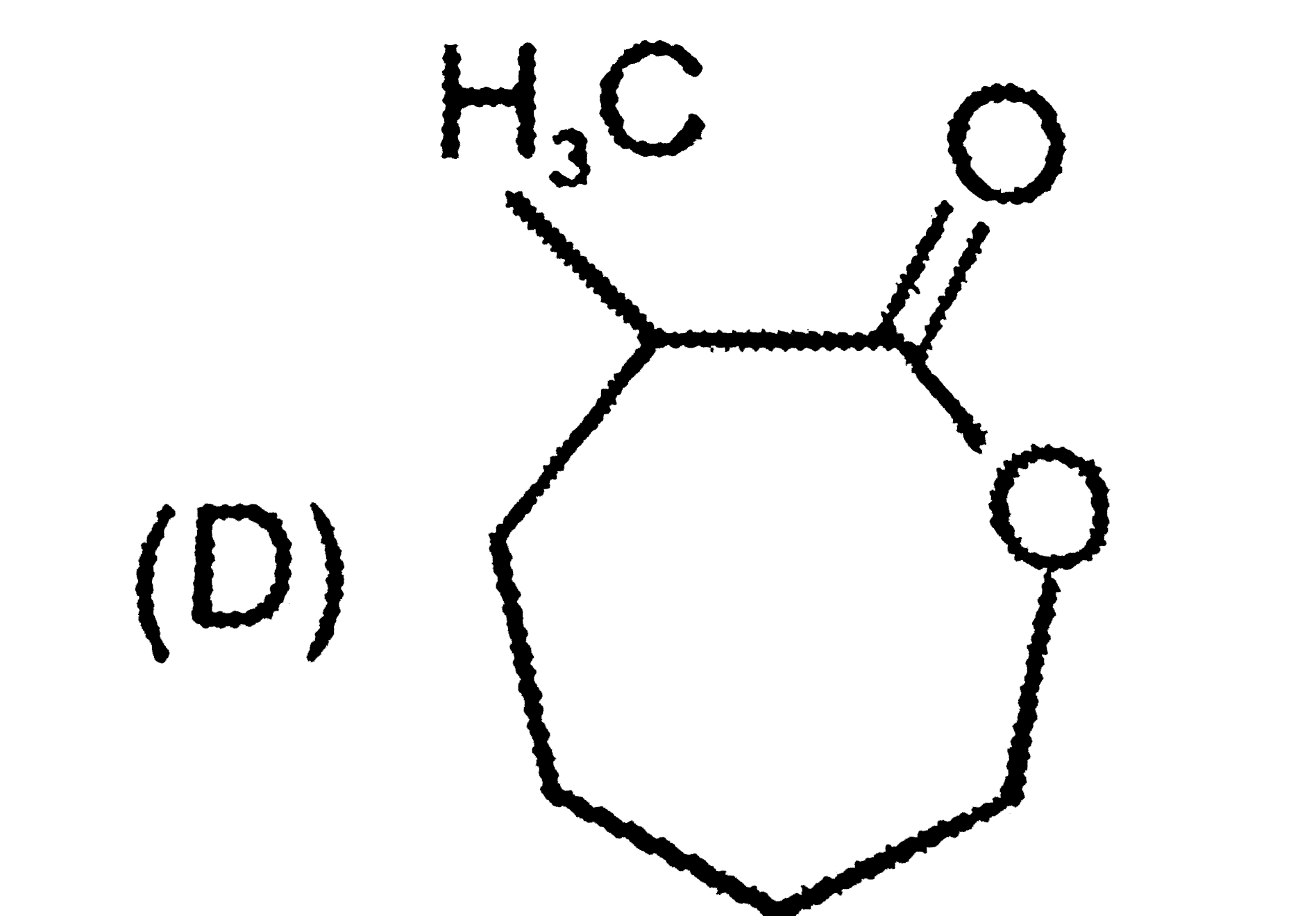2-Methychlcyclohexanone is allowed to react with matachloroperbenzoic acid. The major product in the reaction is




The correct Answer is:C
To solve the question regarding the reaction of 2-methylcyclohexanone with meta-chloroperbenzoic acid, we will follow these steps:
Step 1: Understand the Reactants
- 2-Methylcyclohexanone: This compound has a cyclohexane ring with a ketone (C=O) functional group at the second carbon and a methyl (CH₃) group at the same position.
- Meta-chloroperbenzoic acid (m-CPBA): This is a peracid that can introduce an oxygen atom into the carbon skeleton through an epoxidation reaction.
Hint: Identify the structure of both reactants to visualize the reaction mechanism.
Step 2: Reaction Mechanism
- The reaction involves the nucleophilic attack of the carbonyl oxygen of 2-methylcyclohexanone on the electrophilic oxygen of m-CPBA.
- The oxygen in the peracid will act as an electrophile, and the carbonyl oxygen will act as a nucleophile.
Hint: Remember that nucleophiles donate electrons to electrophiles in a reaction.
Step 3: Formation of the Epoxide
- Upon the reaction, an epoxide is formed. The oxygen from m-CPBA will form a three-membered cyclic ether with the carbonyl carbon of 2-methylcyclohexanone.
- This results in the formation of an intermediate with a cyclic structure.
Hint: Look for the formation of a three-membered ring (epoxide) in the product.
Step 4: Ring Opening
- The epoxide can undergo ring-opening in the presence of acid or water, leading to the formation of a hydroxyl group (-OH) on one of the carbons of the original ketone.
- The other carbon will retain the original substituents, including the methyl group.
Hint: Consider how the epoxide can be opened and what functional groups will remain in the final product.
Step 5: Identify the Major Product
- After the ring-opening, the major product will be a 7-membered ring compound with a hydroxyl group and the original methyl group retained.
- The final structure can be named as 7-methyl-oxepan-2-one.
Hint: Ensure to check the final structure for the correct number of carbons and functional groups.
Conclusion
The major product formed from the reaction of 2-methylcyclohexanone with meta-chloroperbenzoic acid is 7-methyl-oxepan-2-one. Therefore, the correct option is C.
- 2-Methylcyclohexanone: This compound has a cyclohexane ring with a ketone (C=O) functional group at the second carbon and a methyl (CH₃) group at the same position.
- Meta-chloroperbenzoic acid (m-CPBA): This is a peracid that can introduce an oxygen atom into the carbon skeleton through an epoxidation reaction.
- The reaction involves the nucleophilic attack of the carbonyl oxygen of 2-methylcyclohexanone on the electrophilic oxygen of m-CPBA.
- The oxygen in the peracid will act as an electrophile, and the carbonyl oxygen will act as a nucleophile.
- Upon the reaction, an epoxide is formed. The oxygen from m-CPBA will form a three-membered cyclic ether with the carbonyl carbon of 2-methylcyclohexanone.
- This results in the formation of an intermediate with a cyclic structure.
- The epoxide can undergo ring-opening in the presence of acid or water, leading to the formation of a hydroxyl group (-OH) on one of the carbons of the original ketone.
- The other carbon will retain the original substituents, including the methyl group.
- After the ring-opening, the major product will be a 7-membered ring compound with a hydroxyl group and the original methyl group retained.
- The final structure can be named as 7-methyl-oxepan-2-one.
The major product formed from the reaction of 2-methylcyclohexanone with meta-chloroperbenzoic acid is 7-methyl-oxepan-2-one. Therefore, the correct option is C.
Topper's Solved these Questions
- CARBONYL COMPOUNDS (ALDEHYDES & KETONES ) & CARBOXYLIC ACID BOOK - RESONANCE ENGLISHCHAPTER - CARBONYL COMPOUNDS (ALDEHYDES & KETONES ) & CARBOXYLIC ACID EXERCISE - Part -IV
23 Videos
- CARBONYL COMPOUNDS (ALDEHYDES & KETONES ) & CARBOXYLIC ACID BOOK - RESONANCE ENGLISHCHAPTER - CARBONYL COMPOUNDS (ALDEHYDES & KETONES ) & CARBOXYLIC ACID EXERCISE - Part -II
39 Videos
- BIOMOLECULES & POLYMERBOOK - RESONANCE ENGLISHCHAPTER - BIOMOLECULES & POLYMEREXERCISE - ORGANIC CHEMISTRY(Biomolecules & Polymer)
34 Videos
- CHEMICAL KINETICSBOOK - RESONANCE ENGLISHCHAPTER - CHEMICAL KINETICSEXERCISE - PHYSICAL CHEMITRY (CHEMICAL KNIETICS & RADIOACTIVITY)
49 Videos
Similar Questions
Knowledge Check
2-Methylcyclohexanone is allowed to react with metachloroperoxobenzoic acid. The major product formed in the reaction is:
A B
B C
C D
D
The major product (X) of the reaction is :
 A
A B
B C
C D
D
The major product of the reaction is:

View SolutionThe major product of the following reaction is:

View Solution2-Methylcyclohexanone is allowed to react with metachloroperoxobenzoic acid. The major product formed in the reaction is
View SolutionThe major product (C) in the reaction is :
 .
.
View Solution
Major product of this reaction is
View SolutionThe major product in the following reaction is :

View Solution


